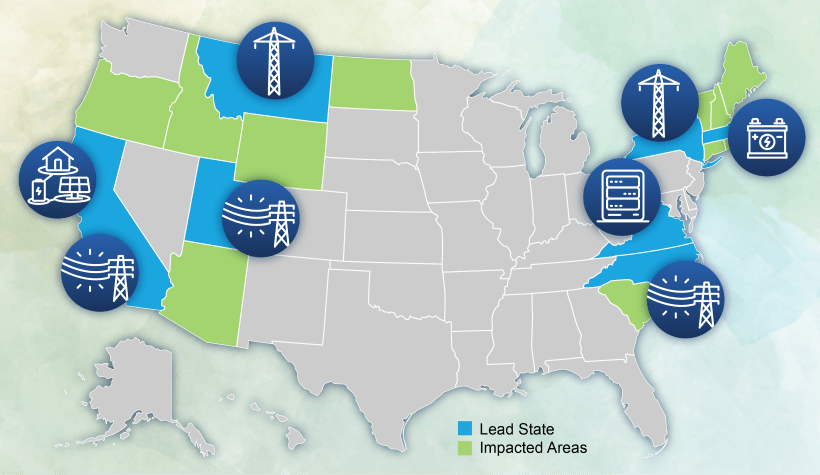By now you are well aware that the U.S. Senate has passed a mammoth $1.2T bill investing in infrastructure. You may even know that the energy investments were around $100B – a lot of funds no doubt. What you may not have been able to sparse out in the 2700 pages and various steps is exactly what’s in there and what isn’t. Even with funding of this level, there are aspects of the energy grid that made it in the package and some that did not.
What’s In the Bipartisan Package
Resiliency
Right off the top of the energy title are a few sections that invest $11B over the next five years to fund deployments that harden our grid to increasing disturbances and disruptions. In 2020 alone, over 20 $1B+ events occurred impacting our lives and communities deeply, so this is a starting point for proactive investment to address the downside of these events. Additional aspects in the package invest in wildfire mitigation efforts including treatment of forest and new commission for coordinated planning. Sen Wyden of Oregon called for funding of $50B in his Disaster Safe Power Grid Act for wildfire work alone, so while this funding is a great start it is not enough to meet the needs of the grid.
Hydrogen
Much talk in the industry surrounds the concept of longer duration storage and one solution may come in the form of a dramatic expansion of hydrogen capacity. The bipartisan bill places a big bet with research, demos, and regional hubs totaling upwards of $10B in this area. It’s not quite as big as the investments that Europe is making in the area but it would be an unprecedented infusion of funds into this space in No. America.
Nuclear
There has been wide coverage of the inclusion of nuclear support in the infrastructure package. Funds to help the few remaining resources in development in this capital intensive sector are somewhat significant, however, for the future of this industry, even an investment of over $9B for demos and projects (including smaller scale modular) may only make a moderate impact.
Carbon Capture
Another area that got a rather significant boost in this package is carbon capture, sequestration, storage and utilization. Between demos and other funding support this area receives about $12B. Finding effective ways to use and store carbon is certainly going to play a central role in our future, but hopefully, this will not be an uneconomic use of extending assets on our system.
What’s In There but Only Somewhat
Modernization
One of the central aspects of the 2008 ARRA stimulus related to energy was a program that funded grid advancements via the smart grid investment grant projects. One section of the bipartisan bill rekindles this program with $3B in funding. What constitutes a smart, modern grid to help develop necessary grid flexibility has advanced quite a lot in the last 13 years, so this program may be a bit limited in scope but has a good starting place. The needs for the grid to instrument expanded flexibility have also advanced, so while this offers critical investment, significant expansion will be necessary for the near term.
Electric Vehicles
Much has been noted about how the package will transform electrified transportation. Yes, there is $7.5B for charging infrastructure, and yes there is another $2.5B for electrified buses (other portions are for other clean transit). But in the overall scheme of what it will take to transition the transportation system, this is a rather minor commitment.
Is the bipartisan package a major investment in our grid? YES! Is this something that the House should take up and pass as soon as possible? YES!
Bryce Yonker, executive director, Grid Forward
Energy Storage
Any energy insiders know that one of the keys to a smoother transition of our energy system is a dramatic expansion of energy storage. This package indeed includes $3B for second use and recycling demos and another $3B for supply chain materials support. However, by way of accelerating deployments of grid storage, this package actually does quite little. Even in the promising area of longer duration demos it only allocates a minor $150M and another section calls for one demonstration project.
Buildings and Efficiency
The overall level of funding and support for efficiency and buildings was somewhat limited in the package. Sure, there was the nearly $500M for revolving loan fund and building codes, and $500M for efficiency and renewables on schools, $3.5B for weatherization funds, and some funds for states that could go to these areas, but it overall was a rather small level of support. The concept of the first resource being the one you don’t build – Amory Lovins now famous negawatt – needs to remain a central part of the grid we are making.
Transmission
Political talking points play up how much support the package has for building out transmission infrastructure. There is a section that identifies critical transmission corridors, but it does not fund them. There is another section that creates a new authority with the ability to offer loans up to $2.5B to support transmission programs with early commercial interest. But this package does not fund, for example, long high-voltage transmission projects or create significantly streamlined processes for these areas moving ahead. Rolling up sleeves to get into the details on permitting and siting on transmission will remain critical and didn’t seem to substantially move in this package.
Cybersecurity
It really has been shocking under investment in grid cyber hygiene and hardening over recent years from federal resources and that cyber funding has not been part of any major energy legislation for over a decade. This package does have $250M that will help small, mostly rural utilities with the cyber capabilities and another $350M that will go quite a way to support other cybersecurity programs, but this is not an area to under invest in and it seems it was under invested in the package.
What’s Not In The Package
Demand-Side Flexibility
Demand response and wider demand side management capabilities are essentially not funded in the bi-partisan package. One section encourages utility demand side management considerations, but no real funding goes to bringing demand side resources on the grid. With the potential of FERC 2222 to bring aggregated demand side and distributed resources into markets, much more widely available and adopted controllable devices, and other market developments necessitating the type of resource coming on the grid, this is a bit striking.
Building Automation
Support to ensure that buildings have higher level controls and capabilities to respond to grid signals was also not in the package. See comments in demand side and DER integration above and below.
Distributed Resource Integration
It’s not a future state, but a current need, in which aggregated edge resources can provide significant value to the grid. Turning distributed assets (solar, storage, EVs, thermostats, generators, hot water heaters, and much more) into a resource requires new technology, evolved models, new partnerships and more. Support to help this transition is essential. When well established values can be equitably dispersed to owners and all grid customers (and for the benefit of the system itself), we will have reached a new milestone in the evolution of our energy system – the grid has not reached this place yet and investing to get there is critical.
Analytics & Digital Infrastructure
Real-time grid telemetry to better understand and optimize the dynamics of the system was essentially not in the package and is also not present in most parts of the grid. What’s the saying ‘you can’t manage what you don’t measure?’ Are there exciting things you can do with the roughly 70% of advanced meters that are now deployed? Absolutely! But additional investments are required to apply a suite of capabilities, largely powered by the cloud, to the grid and it’s time that we take them off the shelf and use them.
Renewable Energy
Remember that part of the grid that actually creates the energy we need to run our economy? There are a handful of minor areas of investment in targeted deployments and demonstrations here and there offering a few hundred million dollars. But this package does not help fund the build-out of clean energy resources, nor the grid capabilities to help facilitate it. Economics of resources like wind and solar in many jurisdictions are just so cost-effective that their additions have largely won out over recent years, but if we want a lower carbon society we have to dramatically expand renewable resources. And, importantly, we must build a grid that ensures affordable, reliable power gets to people and businesses when they need it. It seems that the reconciliation package may have central aspects to helping support the further build-out of clean energy resources, but if the IPCC report that came out this week didn’t wake you up to the needs I’m not sure what else may.
What’s Next
The House looks like it will be coming back from recess early later this month to continue work on the infrastructure package. Details of the reconciliation package may be together by mid-September. Early outlines show that of the $198B in energy, the clean energy spending may be a significant portion there and in the $67B for the environment, the clean energy accelerator may be a central feature there.
There are rumblings of the reconciliation package having aspects such as:
- More significant support for electrified transportation
- Tax and other incentives for storage, transmission and other grid infrastructure
- Deeper support for efficiency, connected building and related areas
In Summary: Pass This Package
Is the bipartisan package a major investment in our grid? YES! Is this something that the House should take up and pass as soon as possible? YES! Would another $200B (or more) for energy and grid in a reconciliation package help move the functionality of our system ahead? YES! Should the reconciliation package take areas of grid modernization and flexibility further? ABSOLUTELY. Should the bi-partisan package wait and risk not coming across the line as the reconciliation package comes together? We say no, but understand that there are significant political dynamics in play. If the bi-partisan package falls through and so does the reconciliation package, support for the nation’s electric grid and the functionally we want (and really need) during the energy transition will be far below where it needs to be. It’s time that we dig into modernizing our energy system, let’s get this bill across the line and get to work.



